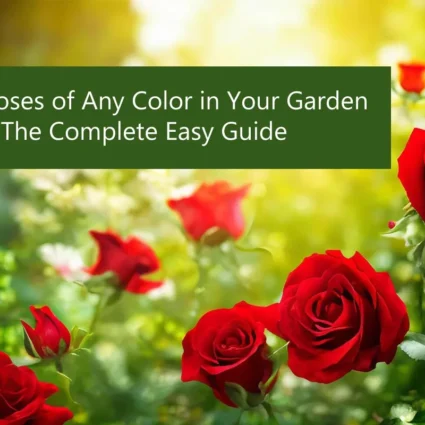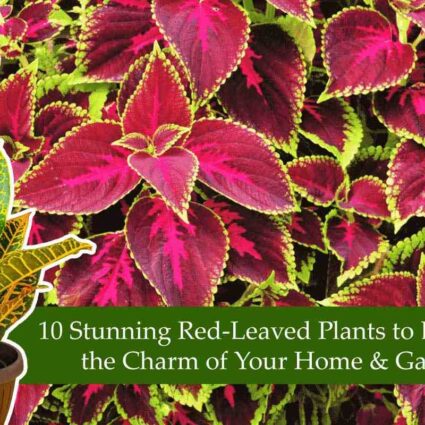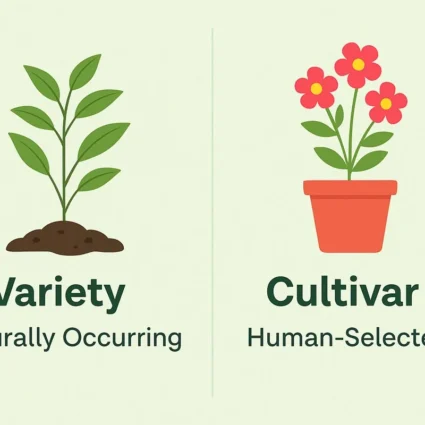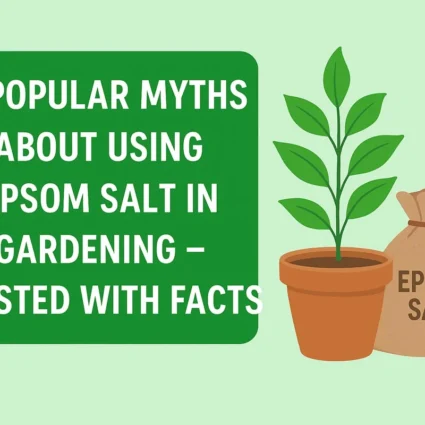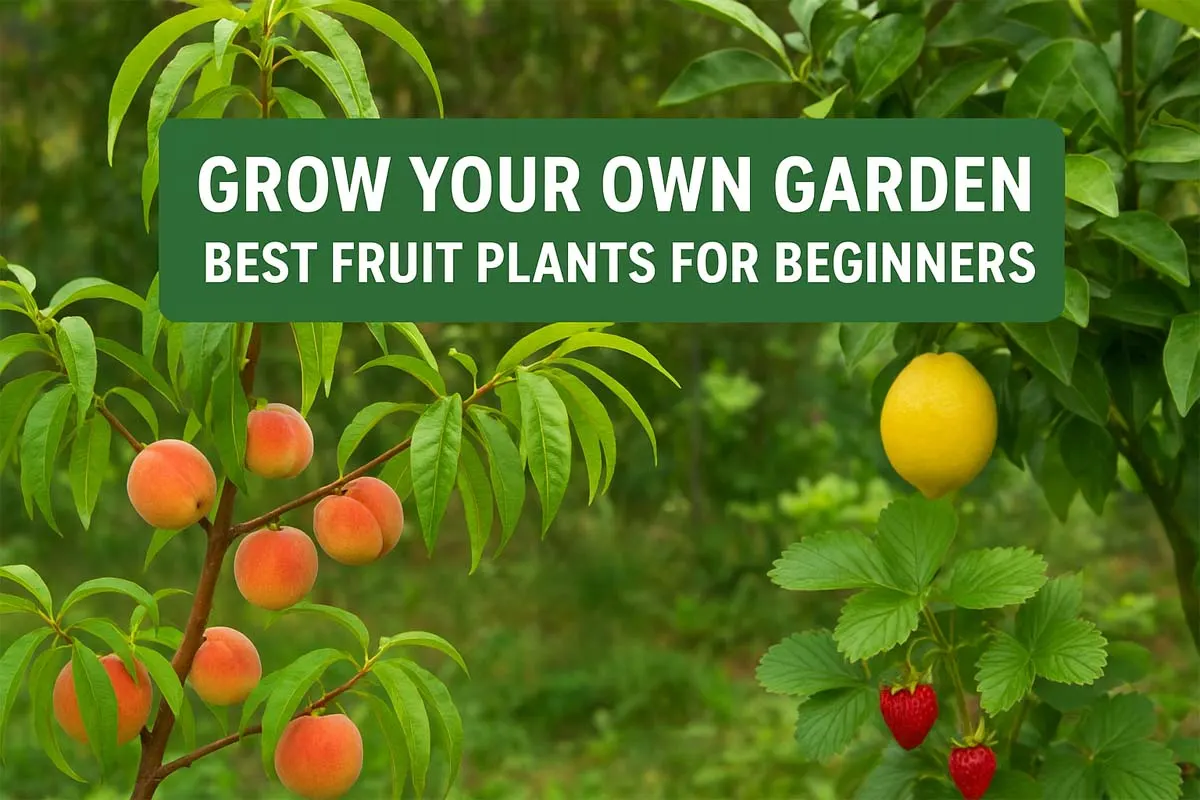
Grow Your Own Garden: Best Fruit Plants for Beginners
Growing your own fruits is more than just a hobby – it’s a movement that’s sweeping across the globe. In cities where supermarket fruits are often expensive, chemically ripened, or shipped from thousands of miles away, home gardeners are rediscovering the joy of plucking a fresh guava, lemon, or strawberry straight from their own garden.
For beginners, starting a fruit garden can feel intimidating. Many people believe that fruit trees take years to bear, need huge spaces, or demand expert care. But the truth is, there are dozens of beginner-friendly fruit plants that thrive even in balconies, terraces, or small backyards. With the right choices, you can enjoy home-grown bananas, papayas, figs, or even exotic delights like passion fruit and blueberries.
This guide is designed to help first-time gardeners choose the right fruit plants, understand their needs, and build a step-by-step plan to enjoy their own sweet harvest. Whether you live in a tropical Indian city, a suburban home in Europe, or a small apartment in the US with a sunny balcony – this list will help you kickstart your journey into fruit gardening.
Why start with fruit plants?
Home-grown fruit is fresher, nutrient-dense, and shockingly flavorful. Many fruits are beginner-friendly, thrive in containers, and fruit within the first 6–18 months. The trick is choosing species matched to your climate, sunlight, and space—and avoiding slow, high-maintenance varieties at the start.
Quick Picks – Beginner-Friendly Fruit Plants
Here’s a 50-fruit list with difficulty level, growth time, and space needs so you can pick what suits your garden best:
| Fruit Plant | Difficulty | Growth Time (from planting) | Space Needed | Ideal Climate |
|---|---|---|---|---|
| Banana | Easy | 10–12 months | Medium | Tropical |
| Guava | Easy | 2–3 years | Medium | Tropical/Subtropical |
| Papaya | Easy | 8–12 months | Medium | Tropical |
| Lemon | Easy | 1–2 years | Small–Medium | Tropical/Subtropical |
| Orange | Moderate | 3–4 years | Medium–Large | Tropical/Temperate |
| Mango | Moderate | 3–5 years | Large | Tropical |
| Pomegranate | Easy | 2–3 years | Medium | Semi-Arid/Tropical |
| Grapes | Moderate | 2–3 years | Requires Trellis | Mediterranean/Temperate |
| Strawberry | Easy | 3–6 months | Small | Temperate/Subtropical |
| Pineapple | Easy | 18–24 months | Medium | Tropical |
| Apple | Moderate | 3–5 years | Large | Temperate |
| Chikoo (Sapodilla) | Easy | 3–4 years | Large | Tropical |
| Custard Apple | Easy | 2–3 years | Medium | Tropical/Subtropical |
| Watermelon | Easy | 3–4 months | Medium Ground Space | Tropical |
| Muskmelon | Easy | 3–4 months | Medium Ground Space | Tropical |
| Dragon Fruit | Moderate | 1–2 years | Medium + Trellis | Tropical/Subtropical |
| Jamun (Black Plum) | Easy | 3–4 years | Large | Tropical |
| Lychee | Moderate | 4–5 years | Large | Subtropical |
| Kiwi | Moderate | 3–4 years | Trellis/Support | Temperate |
| Cherry | Moderate | 3–5 years | Large | Cold Temperate |
| Mulberry | Easy | 2–3 years | Medium | Tropical/Temperate |
| Gooseberry (Amla) | Easy | 3–4 years | Medium | Tropical |
| Pear | Moderate | 3–4 years | Large | Temperate |
| Fig | Easy | 2–3 years | Medium/Pot | Mediterranean/Temperate |
| Raspberry | Moderate | 2–3 years | Small–Medium | Temperate |
| Blackberry | Moderate | 2–3 years | Medium | Temperate |
| Passion Fruit | Easy | 1–2 years | Trellis Required | Tropical/Subtropical |
| Starfruit (Carambola) | Easy | 2–3 years | Medium | Tropical |
| Avocado | Moderate | 3–5 years | Large | Subtropical/Tropical |
| Coconut | Moderate | 4–6 years | Large | Coastal Tropical |
| Jackfruit | Easy | 3–4 years | Large | Tropical |
| Olive | Moderate | 3–5 years | Large | Mediterranean/Arid |
| Loquat | Easy | 2–3 years | Medium | Subtropical |
| Blueberry | Moderate | 2–3 years | Small (pots ok) | Temperate |
| Cranberry | Moderate | 2–3 years | Small | Cool Temperate |
| Plum | Moderate | 3–4 years | Large | Temperate |
| Persimmon | Moderate | 3–5 years | Large | Temperate |
| Sapote (White Sapota) | Easy | 3–4 years | Large | Tropical |
| Rambutan | Moderate | 4–5 years | Large | Tropical |
| Longan | Moderate | 3–4 years | Large | Tropical |
| Elderberry | Easy | 2–3 years | Medium | Temperate |
| Clementine (Mini Orange) | Easy | 2–3 years | Small–Medium | Subtropical |
| Tangerine | Easy | 2–3 years | Medium | Tropical/Subtropical |
| Cranberry Hibiscus | Easy | 1 year | Small | Tropical |
| Carissa (Karonda) | Easy | 2–3 years | Small Hedge | Tropical |
| Quince | Moderate | 3–4 years | Large | Temperate |
| Medlar | Moderate | 3–4 years | Medium | Temperate |
| Currants (Red/Black) | Easy | 2–3 years | Small | Cool Temperate |
| Bael (Wood Apple) | Easy | 3–4 years | Large | Tropical |
| Bilimbi | Easy | 2–3 years | Medium | Tropical |
The Best Beginner Fruits (and exactly how to grow them)
1) Strawberries (containers, towers, hanging baskets)
- Why they’re great: Fast, rewarding, kid-friendly. Day-neutral types fruit over a long season.
- Soil: Light, well-drained mix; keep evenly moist.
- Feed: Every 2–3 weeks with balanced liquid fertilizer.
- Care hacks: Remove first flush of flowers in week 2–3 after planting for stronger plants; refresh plants every 2–3 years.
2) Dwarf Lemons/Limes (balcony citrus hero)
- Best picks: ‘Improved Meyer’ lemon, ‘Bearss’ lime, ‘Kaffir’ lime (for leaves).
- Potting: Free-draining citrus mix in a 10–15 gal pot; raise on feet for drainage.
- Water: Deeply, then let the top 2–3 cm dry.
- Fruiting tip: Keep indoors by a bright window in cold winters; hand-pollinate flowers with a soft brush if indoors.
3) Figs (the fool-proof fruit tree)
- Varieties: ‘Brown Turkey’, ‘Celeste’, ‘Violette de Bordeaux’.
- Why pots help: Restricts roots → more fruiting.
- Prune: Light prune in dormancy to keep compact; pinch tips in summer for branching.
- Harvest: When fruits droop slightly and neck softens.
4) Blueberries (beautiful + delicious)
- Key to success:Acidic soil (pH 4.5–5.5). Use ericaceous mix + rainwater if possible.
- Companions: Plant 2 varieties for bigger crops, even if self-fertile.
- Mulch: Pine bark/needles to preserve acidity and moisture.
5) Dwarf Bananas (instant tropical vibe)
- Space: Large pot (60–90 L); heavy feeder.
- Wind: Shelter leaves from strong winds.
- Winter: Move to a warm, bright spot; mulch heavily outdoors in mild climates.
- Bonus: Edible blooms and pups (baby plants) to propagate.
6) Pineapple (zero-fuss conversation piece)
- Planting: Twist off a healthy crown, remove lower leaves, dry 2–3 days, then plant shallow.
- Light: Maximum sun; warm temps.
- Water: In the central cup during hot spells; avoid soggy soil.
- Fruiting: Top-heavy plant—use a weighty pot for stability.
7) Guava (dwarf, fragrant, forgiving)
- Soil: Any well-drained mix; tolerates neglect once established.
- Prune: Shape into a small bush; remove water sprouts.
- Pollination: Usually self-fertile; attracts bees—balcony bonus!
8) Pomegranate (ornamental + resilient)
- Why beginners love it: Handles heat, drought, poor soil.
- Prune: Keep as a multi-stem shrub; remove basal suckers.
- Water: Deep but infrequent for sweeter arils.
9) Dwarf Mulberry (fastest sweets on a stem)
- Yield: Prolific; fruits on new growth.
- Prune: Hard prune after harvest to keep compact and stimulate fresh fruiting wood.
10) Passionfruit (vertical harvests)
- Support: Trellis or balcony railing; tie gently.
- Feed: High-potash fertilizer once vines establish.
- Watch for: Suckers from rootstock—remove promptly.
Also Read This :Air Pots vs. Fabric Pots: Which Is Best for Indian Gardeners?
Container, Soil & Feeding 101 (Beginner Blueprint)
Containers: Start with food-safe plastic or fabric pots (cooler roots, great drainage). Size up as plant grows.
Soil mix (universal): 40% high-quality potting mix + 30% compost + 20% coco peat + 10% perlite/pumice.
Drainage: 1–2 cm coarse material at bottom; raise pots on feet.
Fertilizer:
- Establishing (weeks 1–6): Half-strength balanced liquid feed weekly.
- Bloom/fruit set: Higher K (potassium) every 2 weeks (e.g., tomato feed).
- Organic option: Worm tea/seaweed every 2–3 weeks + slow-release organic granules every 8–10 weeks.
Mulch: 2–4 cm organic mulch (cocoa husk, straw, pine bark) to reduce evaporation.
Also Read This :Monsoon Plants That Purify Air and Repel Mosquitoes — A Natural Home Shield
Sunlight & Watering (The Only Two Things You Must Get Right)
- Sun: Most fruit needs 6–8 hours direct light. If you only get 3–4 hours, choose strawberries, blueberries (bright shade ok), or dwarf citrus under grow lights.
- Water: Deep, infrequent watering > frequent sips. Let top layer dry before the next soak.
- Finger test: If top 2–3 cm are dry, water. If cool and damp, wait.
- Summer tip: Morning watering reduces disease and evaporation.
A Simple 12-Week Starter Plan
Weeks 1–2: Buy 3–4 starter plants (one citrus, one berry, one fast fruit like mulberry or strawberry). Pot up, label, mulch.
Weeks 3–4: Start gentle feeding; train vines to supports.
Weeks 5–8: Remove weak shoots; hand-pollinate indoor citrus; watch for pests.
Weeks 9–12: First harvests from strawberries/mulberries; repot any root-bound plants.
Common Beginner Mistakes (and quick fixes)
Too little sun → Leggy growth, low fruiting.
- Fix: Relocate to the brightest spot; add reflective surfaces or grow lights.
Overwatering in deep pots → Root rot.
- Fix: Use breathable fabric pots; improve drainage; water by the finger test.
Wrong soil pH (blueberries!)
- Fix: Use ericaceous mix; acidify with elemental sulfur or peat-free acidic blends.
No pruning → Jungle plant, little fruit.
- Fix: Light, regular pruning to open the center; remove crossing/weak wood.
Impatient expectations
- Fix: Choose early fruiters (strawberry, mulberry, dwarf lemon) for quick wins.
Also Read This :Do Air-Purifying Plants Really Work? Science vs. Hype
Climate-Smart Starter Bundles
- Tropical/Subtropical: Dwarf banana + guava + passionfruit + pineapple.
- Mediterranean/Warm Temperate: Fig + pomegranate + strawberry + lemon.
- Cool/Temperate (with winters): Strawberry + blueberry (pH-ready) + fig (pot + winter protection).
- Low-Light Balcony: Strawberries + dwarf citrus + herbs; supplement with LED grow light (3000–4000K, 30–40W per 0.5 m²).
Harvest & Taste Tips
- Strawberry: Pick when fully colored and fragrant—don’t wait long after ripening.
- Citrus: Leave on tree longer for sweetness; color isn’t everything—taste test!
- Fig: Soft neck + droop = ready.
- Blueberry: Wait 3–5 days after turning blue for peak sweetness.
Also Read This :Zero-Waste Gardening: A Story of One Family’s Journey to a Greener Life
FAQs
Q1. What’s the easiest fruit for absolute beginners?
Strawberries, dwarf mulberry, and dwarf lemon (Meyer) are the quickest, most forgiving starters.
Q2. Can I grow fruit indoors?
Yes—dwarf citrus, strawberries, figs can work by a south-facing window or under LED grow lights (12–14 hrs/day).
Q3. How big should the pot be?
Berries: 10–12″ wide; dwarf trees: 10–15 gal; vines: 10–15 gal + trellis.
Q4. Do I need two plants for pollination?
Many are self-fertile (lemon, fig, pomegranate). Blueberries yield better with two varieties. Passionfruit depends on type—check label.
Q5. When will I get fruit?
Fast: strawberries/mulberries (3–6 months). Citrus/guava/pomegranate/fig (6–12+ months depending on plant size and season).

